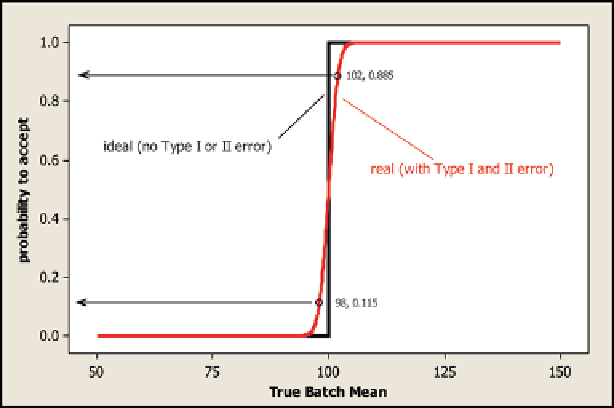Biomedical Engineering Reference
In-Depth Information
Fig. 8.6
Comparison of an ideal step function (
solid black
) versus a real (
solid red
) OCC for a
one-sided limit
The degree to which a real OCC deviates from the ideal step function is influenced
by the magnitude of the indeterminate measurement error, the number of sample
measurements obtained, and the decision rules used to make the disposition deci-
sion. For example, Fig.
8.7
illustrates the impact of increasing the number of repli-
cate measurements and comparing the average of the results to the same limits.
If a different decision rule were employed (e.g., instead of comparing the average
of results as above, the decision rule required that all individual results must meet
the limits), the consequence would be a different set of OCCs (Fig.
8.8
).
The following sections in this chapter focus on applying the concepts of OCCs
to evaluating the performance of the EDA ratio metric (
LPM/SPM
) and conven-
tional stage groupings. Three approaches to generating OCCs were considered in
this work, differing primarily in the level of sophistication and underlying assump-
tions. Fundamentally, to construct an OCC, one needs to specify the proposed
decision-making process together with critical limits and to have or obtain informa-
tion concerning the measurement precision. From this information, one can esti-
mate the probability of a particular decision (accept or reject) as a function of
assumed true values of the quality attribute.
As described above, the OCC work presented here relied on CI results from the
IPAC-RS database. One difference from establishing an OCC in a real QC situation
was that the actual regulatory requirements for APSD of these blinded products
were unknown. For the purpose of comparing the performance of the various met-
rics studied, limits were therefore assumed. As a consequence, the results presented
here reflect the ability of a specified metric to discriminate among product batches
on the basis of those assumed limits (in an “apples-to-apples” comparison).

Search WWH ::

Custom Search